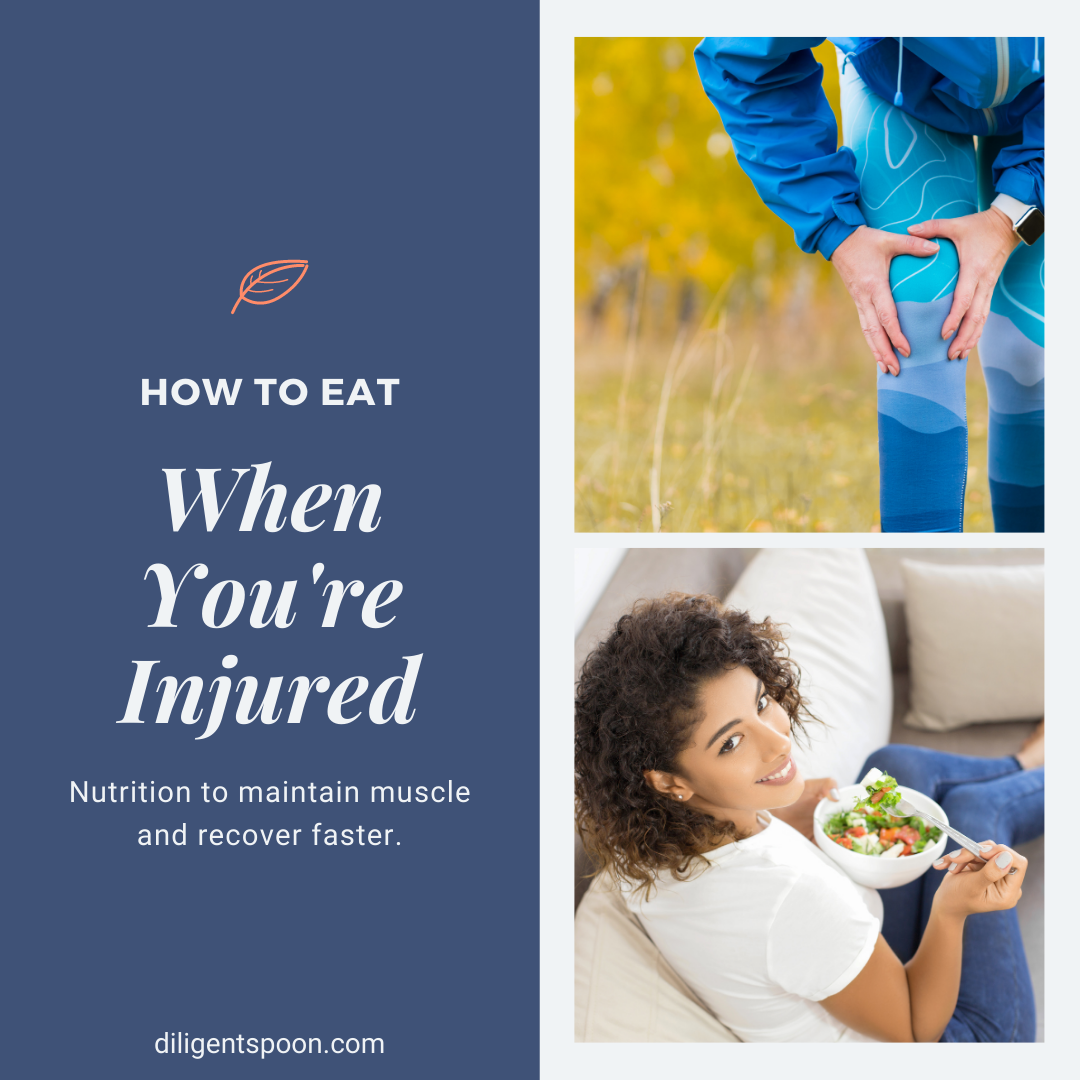
How to Eat When You’re Injured
Have you ever put in weeks (or months) of hard work, only to be sidelined by an injury? Whether you run long distances, play in a volleyball league, or chase you kiddos over playground equipment, injuries can happen to all of us. And, the timing is never right. You might have your food dialed-in for training or being active, but do you wonder how to eat when you’re injured?
Questioning Nutrition During Injury
Nutrition-wise, now what? How do you eat in a way that preserves muscle, promotes healing, and lifts your spirits? (Let’s face it, when laid up on the sofa instead of out doing your favorite activity, you need to enjoy what you’re eating.)
Common questions from injured women – whether they are athletes or not – are:
- What and how much should I eat, now that I’m not working out?
- How do I prevent weight gain?
- How do I keep as much muscle as possible, when I can’t move?
The answers to these questions are individual to each person’s body, sport, and goals. However, with a little knowledge, any athlete (or person with an injury) can plan to eat in a way that promotes healing and maintains wellness.
Why is Nutrition Important During Injury?
What happens when you go from high activity to no activity, due to an injury?
- You lose muscle due to hormonal and inflammatory stress of the injury; metabolic changes reduce your ability to build muscle.
- You lose strength due to being more sedentary and not using the muscle.
- Without your usual activity, your bones lose calcium and magnesium stores.¹
Ladies, recovery time is not the time to worry about losing weight. It’s all about preserving what you have, as much as possible, so you can bounce back after injury. Keep in mind that if you don’t eat enough calories, your body will start to use muscle – not fat – as a fuel source. And that means slower healing and more muscle loss. Use the following principles to guide your food choices during injury and recovery.
How To Eat When You’re Injured
Eat Enough of the Right Protein
The most important thing you can do to minimize muscle loss is to get enough protein. During recovery, women should aim for 1 gram (g) per pound (lb) of body weight (that’s 126 – 154 g for a 140-lb woman). This will slow, but not completely stop muscle loss due to anabolic resistance. ¹
What is anabolic resistance? Anabolic resistance is when you eat enough of the right protein, but you still lose muscle. Being sedentary or injured causes hormonal changes that lead to anabolic resistance. ²
Not all proteins are created equal. In order to build muscle – or in this case, preserve it – you need the very important branched chain amino acid leucine. Leucine is the key amino acid that your muscles need to stop breakdown and encourage building. For maximum recovery, aim to get 30 g of protein, including 3 g of leucine, three times per day.¹ Good sources of leucine-containing protein:
- Lean meats – chicken, lean steak and pork chops, tuna – and eggs.³
- Low-fat dairy milk and Greek yogurt. Why low-fat? Low-fat and nonfat versions have more protein than the full-fat ones.
- Whey Protein powder. You can absolutely get all the protein and leucine you need through foods alone. However, if you’re a vegetarian, allergic to casein or lactose intolerant, or just want to make it easier, whey protein is a good way to go.
- I like Optimum Nutrition’s Gold Standard protein powder. It tastes great, mixes well (no grit), and has 2.5 g of leucine per serving.
- There are many varieties, including non-flavored options like Naked Whey.
- Whey is an animal product, made from cow’s milk. If you’re vegan, choose a complete protein powder with BCAAs (branched chain amino acids), like Vega Clean Protein Powder.

Increase Omega-3 Fatty Acids
Omega-3 fatty acids join forces with amino acids you eat as protein. Together, they make muscles more receptive to using the amino acids to build muscle.⁴ In order to get enough omega-3s for injury recovery, aim for 4 grams per day (2 g in the morning and 2 g in the evening).
Unless you eat a ton of fatty fish, this means you’ll be taking an omega-3 supplement during healing and recovery.¹ For this OmegaWell supplement, I would take 1 – 2 capsules with both breakfast and dinner.
Less Sugar, More Protein and Fiber
Reduce simple carbohydrates (sugar). Skip the recovery drinks, fruit juices, and sugary snacks. These foods are high in simple carbs, which will spike your blood sugar and slow protein absorption.¹ Instead, go with carb sources that also have some protein or fiber with them – yogurt, milk, whole grain bread, whole fruit, beans, vegetables, etc.
For Your Bones: Calcium, Magnesium, and Vitamin D
Get enough calcium, magnesium, and vitamin D for bone health. Counteract bone loss by eating or supplementing with calcium, magnesium, and vitamin D.
Calcium is best absorbed when we get it from food – yogurt, milk (dairy and non-dairy fortified), cheese, sardines, dark leafy greens.⁵ Magnesium and vitamin D are found in many foods. However, our diets tend to be low in these two nutrients, so take magnesium and Vitamin D3 supplements to make sure you’re getting enough.
Drink Water
If you have an injury, the last thing you may want to do is make extra trips to the restroom. Still, getting enough water is key to helping your body rid itself of byproducts from the healing process. Not only that, water is the main ingredient to important fluids like blood and lymph (which transports immune cells).
We want to keep all these things moving, so drink eight cups of water per day (or as much as you can). Don’t love drinking water? Decaffeinated, unsweetened drinks like herbal tea, sparkling water, and decaf coffee also count towards your water intake.
Sleep Helps You Recover From Injury
One more thing: Sleep. Adequate sleep and rest will promote healing and recovery. In contrast, sleep deprivation raises stress hormones, which can lead to bone turnover and loss, among other things. A stressed body will slow or delay healing in order to prioritize dealing with the stress. When you’re injured or recovering, aim for 7 – 9 hours of sleep per night. If you want to improve your sleep, the Sleep Foundation is a great place to start.
Example Day: Eating When You’re Injured
This is a hypothetical day of food for a 140-lb woman with an injury that makes her mostly inactive. She spends her day mostly sitting or reclining, with very few other tasks and no planned exercise.
Calculated using https://tools.myfooddata.com/recipe-nutrition-calculator.
Breakfast:
Breakfast bowl made with sliced banana, lowfat Greek yogurt, almond milk, protein powder, chia seeds, and nut butter. Supplements: Vitamin D and Omega-3
Snack:
Fruit bowl made with chopped fruit, lowfat Greek yogurt, milk, protein powder, and chopped nuts or granola
Lunch:
Tossed salad with spinach or other dark greens, tomato, kalamata olives, broccoli, one roasted chicken thigh and balsamic vinaigrette dressing
Snack:
Handful of kalamata olives, slice or chunk or hunk of cheese, one apple
Dinner:
One-Pan Asian Chicken with roasted vegetables and side salad (example: spinach, tomato, olives or avocado) and dressing of choice. Supplements: Omega-3 and magnesium (Magnesium has a calming effect, so take this close to bedtime.)
Totals:
- Calories: 1900 – 2000
- Carbohydrates: 155 g
- Protein: 135 g *
- Leucine: 9.7 g *
- Fat: 97 g
- Omega-3s: 6.2 g
✱ Note: If one uses dairy milk instead of almond milk in the example day, protein will increase by 8 – 10 grams, leucine by 1.5 grams.
Eat For Healing, Recovery, Pleasure
Being injured or unable to exercise can be painful physically, as well as mentally. Take some of the stress out of recovery by knowing how to eat when your injured. If you can only do one thing, make sure to get plenty of protein (about 1 g per pound of body weight), including the amino acid leucine, to minimize muscle loss.
Other things you can do are: supplement with Omega-3 fatty acids and bone-forming nutrients (calcium, magnesium, and vitamin D), watch your sugar intake, and drink lots of water.
A few supplements, choosing foods that will nourish and that you enjoy eating, and getting plenty of rest will speed recovery and get you off the couch as soon as possible!
References
- Sims, Stacy T. Roar: How to Match Your Food and Fitness to Your Female Physiology for Optimum Performance, Great Health, and a Strong, Lean Body for Life. Rodale, 2016.
- Morton, Robert W., et al. “Defining Anabolic Resistance.” Current Opinion in Critical Care, vol. 24, no. 2, 2018, pp. 124–130., doi:10.1097/mcc.0000000000000488.
- Whitbread, Daisy. “Top 10 Foods Highest in Leucine.” Myfooddata, My Food Data, 7 Oct. 2020, www.myfooddata.com/articles/high-leucine-foods.php.
- Tessier, Anne-Julie, and Stéphanie Chevalier. “An Update on Protein, Leucine, Omega-3 Fatty Acids, and Vitamin D in the Prevention and Treatment of Sarcopenia and Functional Decline.” Nutrients, vol. 10, no. 8, 2018, p. 1099., doi:10.3390/nu10081099.
- Waite, Brandee, et al. The Long Distance Runner’s Guide to Injury Prevention and Treatment: How to Avoid Common Problems and Deal with Them When They Happen. Skyhorse Publishing, 2017.


